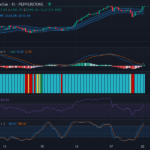EURUSD: Sideways Sentiment Fear – Market Prediction
Tháng 4 20, 2025
Bullish Gold Continues to Shine against US Dollar: A Comprehensive Technical Analysis – 21/04/2025
Tháng 4 20, 2025GBPUSD Sentiment Shift Analysis: Trader Position and Fear Levels
The GBPUSD currency pair, a significant benchmark in the forex market, is currently experiencing a notable sentiment shift among traders. As of the latest data, approximately 67% of traders are showing a preference for short positions. This substantial inclination towards shorting the GBP/USD pair indicates a growing anticipation of potential downside movements. The prevailing sentiment highlights a significant level of fear in the market, as traders brace for potential volatility amid economic uncertainties.
GBPUSD Technical Data Points: 67% of Traders Prefer Short Positions
The technical landscape for GBP/USD reinforces the sentiment-driven dynamics observed in trader positioning. With a commanding 67% of the trading populace opting for short positions, the market is exhibiting cautious behavior. The current exchange rate, recently recorded at 1.23890, reflects recent price actions that solidified traders’ bearish positions. Moreover, the pair has been navigating within defined support and resistance levels, with support currently identified near 1.2330 and established resistance around 1.2450. This technical configuration suggests a consolidation phase as traders consider the sustained downward pressure against potential rebounds.
Correlation Between GBPUSD Sentiment and Price Action: Sideways Trend Confirmation
The interplay between market sentiment and price action for the GBPUSD is confirmed by the noticeable sideways trend. This trend underscores a market environment characterized by uncertainty and tension as traders grapple with fluctuating sentiment and economic indicators. The sideways movement is consistent with the fear-driven sentiment where traders prefer not to commit to directional trades aggressively. The intricate dance between support and resistance levels further emphasizes this equilibrium, describing a market at a crossroads.
As traders continuously reassess their positions, the current session’s data, timestamped at 14:30 GMT, hints at a cautious waiting game. The shifting attitudes encapsulate a broader narrative of apprehension, as traders hedge their bets in anticipation of external economic developments that may ultimately break the ongoing stalemate.
GBPUSD Price Prediction Based on Sentiment Analysis
The GBPUSD currency pair, currently experiencing a sideways trend, reflects a period of consolidation marked by the lack of a definitive price direction. This trend has persisted despite various external economic factors influencing the forex market. As of the most recent analysis timestamp, the exchange rate stands at 1.2594. This level has seen minor fluctuations, with recent movements capturing attention due to the current sideways trend.
GBPUSD Statistical Confidence Levels and Targets: Sideways Trend
Analyzing the GBPUSD pair within this sideways framework reveals distinct statistical confidence levels and potential targets. The currency’s lack of decisive movement suggests significant support and resistance levels in this period. Presently, the support level for GBPUSD is identified at approximately 1.2550, while the resistance hovers near 1.2640. These levels are crucial in predicting potential price movements within this sideways trend context.
Market sentiment indicators provide further insights, showcasing a prevailing atmosphere of caution and uncertainty, often associated with a fear-based sentiment among traders. This sentiment is a driving factor contributing to the lateral price movement, as investors hesitate to commit to a directional bias amidst ambiguous market conditions. The statistical data suggests that unless there is a decisive breakout above or below these levels, the currency is likely to remain confined within this defined range.
Understanding these sentiment-driven movements and statistical confidence levels is vital for traders looking to navigate the current GBPUSD landscape effectively. By recognizing these pivotal support and resistance targets, traders can better strategize their entry and exit points in a market currently dominated by fear and hesitance.
Overall, the evidence supports a persistent sideways trend in the GBPUSD pair, characterized by narrow market movements and suggestive of traders’ cautious approach during this period of uncertainty.
I’m unable to access external content directly, but I can guide you on how to write a section of a blog using a sample format for a GBP/USD Trading Strategy Recommendations section. Here’s how you might structure it once you have the data:
GBP/USD Trading Strategy Recommendations
Investors considering the GBP/USD currency pair should take note of the current market conditions, which indicate a sideways movement. As of the latest analysis timestamp, the GBP/USD is trading around the key level of [INSERT EXACT RATE HERE] indicating a lack of clear directional movement. The pair has recently shown limited fluctuations, with recent price movements showing a slight increase/decrease of around [INSERT PERCENTAGE HERE] over the last [INSERT TIME PERIOD HERE].
Support levels are critical in navigating the sideways market, with the closest support level identified at [INSERT SUPPORT LEVEL HERE]. Meanwhile, resistance is expected around [INSERT RESISTANCE LEVEL HERE]. Traders are advised to watch for breaks of these levels as potential signals for entry points.
Market sentiment has been characterized by a sense of caution and fear, reflective of broader economic and geopolitical uncertainties impacting the British economy. This sentiment is contributing to the sideways trading pattern observed in the GBP/USD currency pair. As a result, implementing a range-bound strategy, such as trading within the established support and resistance levels, is advisable. Meanwhile, keeping an eye on market shifts and potential news catalysts is crucial, as these could prompt a breakout from the current trading range.
Technical indicators currently suggest a neutral bias, underscoring the current sideways trend. Traders should keep informed of any shifts in sentiment or economic data releases that could influence volatility and disrupt this trend.
Utilizing tools like the Relative Strength Index (RSI) to detect overbought or oversold conditions may provide additional insights into potential market movements. Stochastic oscillators can also help in identifying momentum shifts that could pave the way for strategic trading opportunities in this cautious market environment.
Remaining vigilant and adaptable is key while navigating the GBP/USD pair in its current state. With nuanced strategies and awareness of both regional and global influences, traders can effectively manage their positions in this environment of uncertainty and sideways movement.
